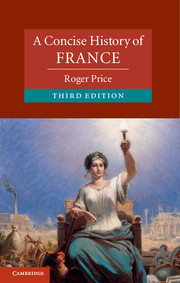Book contents
- Frontmatter
- Contents
- List of Plates
- List of Figures
- List of Tables
- Acknowledgements
- Introduction
- Part I Medieval and Early Modern France
- Part II The Dual Revolution: Modern and Contemporary France
- 4 Revolution and Empire
- 5 The nineteenth century
- 6 A time of crisis
- 7 Reconstruction and renewal
- 8 A society under stress
- A short guide to further reading
- Index
5 - The nineteenth century
continuity and change
Published online by Cambridge University Press: 05 June 2014
- Frontmatter
- Contents
- List of Plates
- List of Figures
- List of Tables
- Acknowledgements
- Introduction
- Part I Medieval and Early Modern France
- Part II The Dual Revolution: Modern and Contemporary France
- 4 Revolution and Empire
- 5 The nineteenth century
- 6 A time of crisis
- 7 Reconstruction and renewal
- 8 A society under stress
- A short guide to further reading
- Index
Summary
The restoration of the Bourbon monarchy in the person of Louis XVIII, brother of the king executed in 1793, was far from representing a return to the pre-revolutionary status quo. The gains of 1789 – constitutional monarchy, representative government, and equality before the law – were recognised in the Charter granted by the king to the nation. In many respects the agenda for political debate throughout the forthcoming century had been established during the long years of internal strife and external war between 1789 and 1815. Sustained mobilisation had created a new political culture. Those who had directly experienced these events transmitted durable mental habits to their children. A wide range of political options had emerged, including reactionary Catholic monarchism, commitment to the liberal principles of 1789, sans-culottes egalitarianism, Jacobin nationalism and Bonapartism. Each of these signified adherence to highly selective references and images of the Revolution (the Declaration of the Rights of Man, the execution of the king, the dominance of Robespierre, of Bonaparte, and so on) that signified fundamentally different value systems, around which political ‘parties’ (not organised bodies until the twentieth century) coalesced and wider support might be mobilised in order to reaffirm or challenge the legitimacy of existing institutions. Over time these ideas underwent frequent, more or less conscious, reinterpretation under the impact not only of political processes but also of socio-economic change already under way during the old century and accelerating in the new. The chronology of change in the economy and society was very different from that in politics, however. Thus the history of the nineteenth century has to be looked at against the background of two revolutions: the industrial as well as the political.
- Type
- Chapter
- Information
- A Concise History of France , pp. 165 - 239Publisher: Cambridge University PressPrint publication year: 2014

